How to Speak Artspeak (Properly)
Robert Atkins introduced the latest edition of his book ArtSpeak at the New York Public Library last nightby admitting that artspeak has gotten a bad rap. “Somehow the language used for describing and discussing art has a reputation for unusual opacity, even sadism,” he said.
That’s the artspeak also known as International Art English, the scourge of artist’s statements, press releases, and catalogues, a language so riddled with semiotic buzzwords that any potential meaning is obscured.
ArtSpeak, the book, is not like that. It’s where you go to find out, quickly and clearly, what Semiotics means.
As its subtitle says, ArtSpeak (Abbeville Press) is a “Guide to Contemporary Ideas, Movements, and Buzzwords, 1945 to the Present.” It offers handy short takes on terms like commodification and formalism, along with the who, when, where, and sometimes why of Neo Dada, Neo-Expressionism, Neo-Geo, New Image, the New Leipzig school, New media, New Realism, New Wave, Nouveau Réalisme, Socialist Realism, Social Realism, Social Practice, Space Art, and Spatialism, to name some more of the 146 categories in the book. It also explains what separates Pathetic Art from kitsch, and how Abject Expressionism differs from Abstract Expressionism.
Atkins has been working at some of these definitions for a while. The first edition of ArtSpeak came out in 1990; the next in 1997. Since then the art world has globalized, digitized, and expanded from the studio and gallery to other disciplines. This new third edition has twice as many categories as the first one did, among them several movements from China and Japan, Contemporary Indigenous Australian Art, Tropicalism from Brazil, the Mission School of San Francisco, and categories including AIDS Art, Black Power Art, and Space Art.
Here are excerpts from 15 of the 30 new additions to the newest version of ArtSpeak. How many do you know?
’85 New Wave
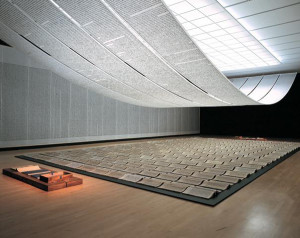
Xu Bing, Book from the Sky, 1987–91, books and ceiling and wall scrolls printed from wooden letterpress type using false Chinese characters. INSTALLATION VIEW AT CROSSINGS, NATIONAL GALLERY OF CANADA, OTTAWA, 1998.
The term ’85 New Wave was coined by critic Gao Minglu to describe a broad-based movement—really an explosion of avant-garde energy—in response to the lifting of the stultifying strictures of the Great Proletarian Cultural Revolution of the 1960s and ’70s.
Targets of the Cultural Revolution included “outmoded” individuals, groups, and institutions—such as intellectuals and well-to-do peasants, universities and temples, and classical architecture and art. Artists were imprisoned or placed under house arrest and sent to labor camps or farms for “reeducation” through agricultural labor and “self-criticism.”
After the deaths of Zhou Enlai and Mao Zedong in 1976, leadership of the by-then discredited Cultural Revolution was assumed by Jiang Qing (Madame Mao) and the Gang of Four, who were subsequently arrested and executed. In 1978 the pragmatic Deng Xiaoping became leader of the Communist Party, replacing Maoist zealotry with utilitarian platitudes such as “Seek truth from facts.” He enabled reforms ranging from the adoption of capitalist banking to the approval of (limited) debate at sanctioned sites such as the so-called Democracy Wall in Beijing, or the (brief and limited) tolerance for the Stars Group of artists.
Abject Expressionism
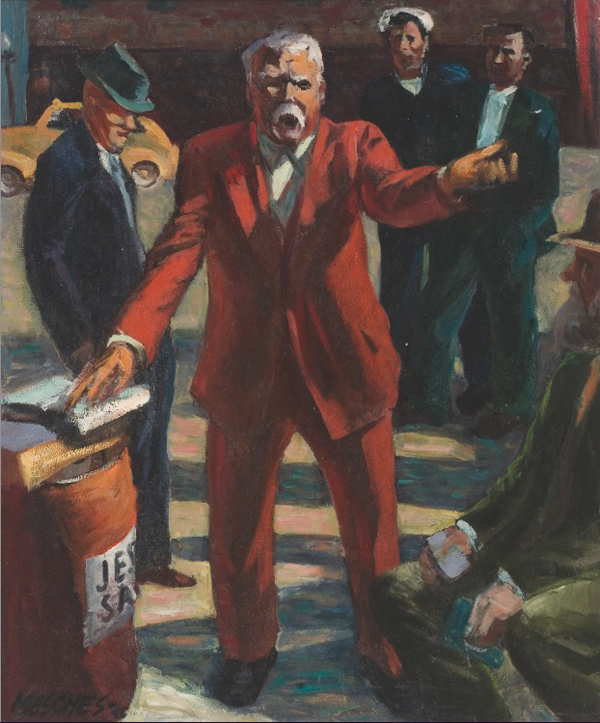
Arnold Mesches, The Plaza Preacher, 1945, oil on canvas. COLLECTION AMY AND ALLEN MUSIKANTOW, OCALA, FL.
Coined by the critic and curator Michael Duncan for the subtitle of his exhibition L.A. Raw at the Pasadena Museum of California Art in 2012, Abject Expressionism is a term that points ahead to twenty-first century approaches to art: it refers to general affinities of tone, theme, and style, without suggesting more precisely what an artwork might look like (as with op art) or its genre or medium (as with body art).
Synonyms that are occasionally heard include Los Angeles Figurative Style and the more general figurative expressionism.
Abject Expressionism refers to works of painting, assemblage, sculpture, and photography produced after World War II by artists in Los Angeles. These dark and humanistic meditations in the wake of Hiroshima and Buchenwald were rendered in figurative styles that ran counter to the Abstract Expressionism that dominated New York. Abject Expressionism also undermines the view of Los Angeles as a backwater whose art scene emerged only in the 1960s….
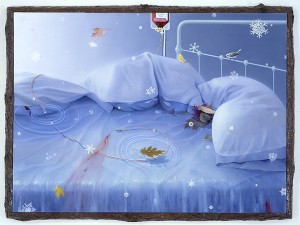
- Frank Moore, Patient, 1997-98, oil on canvas on wood panel with red pine frame. PRIVATE COLLECTION, THE GESSO FOUNDATION AND SPERONE WESTWATER, NEW YORK.
AIDS Art
Echoing the intention of feminist art to truthfully represent the experiences of women, AIDS art arose from a similar concern about people with AIDS. After the initial onset of AIDS in the United States in 1981, only photojournalists produced images of it. Invariably modeled on earlier news photos depicting famines or other catastrophes, these often grisly pictures depressed the spirits of those with HIV and terrified those who did not have it. To counter these “negative” images, activists advocated “positive” portraits of people living with AIDS—that is, images of smiling subjects who looked no different than the average Joe or Jane. This, too, proved an unsatisfying approach that conveyed little information. The modernist single image—the record of the “perfect moment”—was not up to the task of documenting AIDS or other complex subjects; AIDS was among the first signs of its imminent demise.
Black Arts Movement
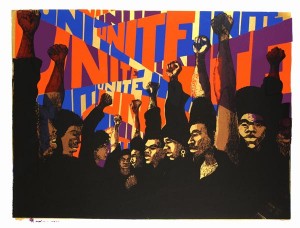
Barbara Jones-Hogu, Unite, 1971, screenprint. FROM THE UPCOMING SHOW ‘CROSSCURRENTS‘ AT MUSEUM OF THE AFRICAN DIASPORA. COURTESY KENKELEBA GALLERY.
The Black Arts Movement is the aesthetic branch of the Black Power Movement…. Leaders of the Black Arts Movement, such as the playwright/poet LeRoi Jones (a.k.a. Amiri Baraka), built upon the political achievements of the Civil Rights movement of the 1950s while demanding a more radical transformation in the arts—and all other aspects of society….
The movement’s effects on music, theater, poetry, literature, and art were profound: It revitalized the work of well-known older artists such as Elizabeth Catlett and Lois Mailou Jones and helped validate figurative imagery that almost invariably announced the race (and gender) of its producers. This catalyzed discussion about the racialized criteria of “quality” in art and about the potential of abstract art to convey complexity in the hands of accomplished practitioners like Jack Whitten or William T. Williams. It also paved the way for artists such as Benny Andrews, Barkley Hendricks, and Betye Saar to follow more easily the dictates of their sensibilities.
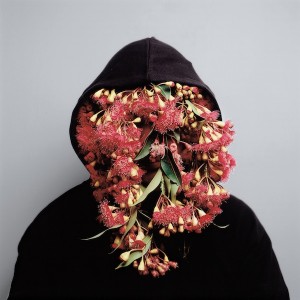
Christian Thompson, Black Gum #2, 2007, C-type print. COURTESY HOOD MUSEUM OF ART, DARTMOUTH COLLEGE: PROMISED GIFT OF WILL OWEN AND HARVEY WAGNER.
Contemporary Indigenous Australian Art
Also known as Aboriginal art, Indigenous Australian art has been made by the Indigenous peoples of Australia since time immemorial…. (Aborigines painted, carved, wove, or engraved sacred images and symbols on rocks, bark, stones, or cave walls.)
As with translations of other indigenous peoples’ religious imagery onto more conventional (and commercially oriented “export”) formats elsewhere the world, the contemporary Indigenous Australian art movement sprang from a variety of impulses and motives both respectful and exploitative, held by players and agents both native and European, and both knowledgeable and ignorant of Indigenous peoples and their art. The process began in 1934, when painter Rex Battarbee taught the Aboriginal artist Albert Namatjira the watercolor medium, with such success that he became the first Aboriginal Australian citizen. In the early 1970s artist Geoffrey Bardon urged Aboriginal people in remote Papunya to translate their “dreamings”—previously drawn on the sand in dots that encoded the locations of secret ceremonies—onto canvas. Despite indiscreet revelations of some tribal secrets, this has become perhaps the most recognizable style associated with Aboriginal Australian culture.
Cynical Realism
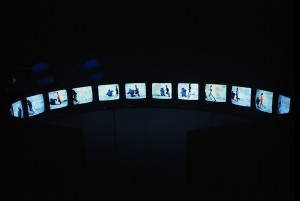
Liu Wei, Crazy Race, 2002, installation view. COURTESY THE ARTIST AND LEHMANN MAUPIN, NEW YORK AND HONG KONG.
The term Cynical Realism was coined slightly after the fact, in 1992, by the critic Li Xianting in an article in the Hong Kong journal The Twenty-First Century. In the same article, he also named the sometimes-overlapping style Political Pop, asserting that the pair of approaches effectively captured the ironic mood of China after 1989.
The shared characteristics of the two styles can make representative examples of them difficult to distinguish.
…Like American pop art, this hyperrealistic style was put to untraditional ends. Cynical Realist works assault the idealization and groupthink of Socialist Realism through disturbing group portraits of nearly identical figures, such as the men in Yue Minjun’s works, with their identical idiotic smiles, or the families in Zhang Xiaogang’s Bloodline series, which underline the genetic similarity of the Chinese citizenry.
Gutai
Gutai means “concreteness” and was the name chosen by the painter Jiro Yoshihara for the group of artists he founded in Ashiya (near Osaka) in western Japan. Comprising twenty artists at the time of its founding in July 1954, the Gutai Art Association spanned two generations and numbered fifty-nine artists over its eighteen-year existence. Yoshihara exhorted young artists to reject tradition and seek new and direct—that is, concrete—encounters with the materials of art, regarded as metaphors of forceful encounters with life itself. In the wake of postwar devastation, Yoshihara’s call to action was an antidote to existential despair. He concluded the Gutai Art Manifesto (1956) by stating that “our work is the result of investigating the possibilities of calling the material to life” and “we hope…that the discovery of new life will call forth a tremendous scream in the material itself.”
Mission School
The term Mission School was coined by art critic Glen Helfand and first appeared in print in the San Francisco Bay Guardian in 2002….the work of the Mission School artists would range from spray-painted tags to discreetly stenciled images with captions. The astonishing success of graffiti art in New York a decade earlier would also provide inspiration.
The members of the Mission School [Apek, CUBA, Bill Daniel, Chris Johanson, Margaret Kilgallen, Barry McGee, Ruby Neri, Dan Plasma, Rigo 23, Clare Rojas] were mostly graduates of the San Francisco Art Institute, a longtime incubator of countercultural approaches and attitudes. These artists did not, however, make up a formal group; they neither issued a manifesto nor pursued collective goals, with one exception: Around 1990 several of them collaborated on indoor installations in municipal venues including the Yerba Center for the Arts and the South of Market Cultural Center. These were their most engaging productions, taking the form of vivid three-dimensional “murals” composed of found objects and overlapping drawings applied directly to the wall, blurring the boundaries between the contributions of different artists.
New Media
New media is a blanket term that once referred exclusively to the genre of art produced by mechanical reproduction in media more recently invented than photography—that is, beginning with video. (New media was initially defined in opposition to the long-established media of photography, painting, and sculpture; in art schools, it was sometimes paired with performance under the rubric of time-based art.) The use of new mediain this sense was primarily limited to schools and museums, where it continues to be employed in this way.
New media has acquired a second, more widespread, non-art meaning, referring to all forms of digital mass media, in contrast to “old media” such as print newspapers or magazines. Confusingly, it is also occasionally used in reference to private means of electronic communication, such as e-mail.
Outsider Art
Roger Cardinal coined the term outsider art for his book of the same name, published in 1972. Originally intended to describe the art of those outside of society, such as prisoners and psychotics, it has come to be used more broadly to describe art by self-taught or naïve artists.
Although outsider artists lack formal training, they are often obsessively committed to their art making. Their works may appear to be innocent, childlike, and spontaneous, but this is usually deceptive. Outsider artists frequently borrow conventional compositions and techniques from the history of art, and many maintain a remarkably consistent level of quality.
There is a general outsider style. In painting this tends toward bright colors, abundant detail, and flat space. In sculpture (or architectural constructions), it often involves assembling junk or cast-off materials in exuberant constructions such as Simon Rodia’s Watts Towers in Los Angeles or in extravagantly decorated environments that have grown out of the artist’s living space, such as Grandma Prisbrey’s Bottle Village, also in Southern California.
Pictures Generation
The Pictures Generation takes its name from a 2009 exhibition at the Metropolitan Museum of Art (The Pictures Generation, 1974–84), which in turn tips its hat to the 1977 show Pictures, curated by the art historian Douglas Crimp at the Artists Space gallery in New York.
The Metropolitan Museum show included artists who were not represented in the initial exhibition—such as Cindy Sherman and Laurie Simmons—but all of them had been casually referred to as “pictures artists” since the 1990s, probably for want of a better name.
The artists of the Pictures Generation were mostly graduates of the California Institute of the Arts at Valencia (CalArts) and the Department of Visual Studies of the University at Buffalo (also known as SUNY Buffalo), both known for their adventurous curricula. When Artists Space director Helene Winer founded the Metro Pictures Gallery with Janelle Reiring in 1980, many of these artists would find a congenial home there.
Social Practice
The origin of the term social practice is a mystery. Synonyms for it are public practice, participatory art, dialogical aesthetics, and relational aesthetics, the last phrase from the influential 1998 book of the same name by the French art historian and theorist Nicolas Bourriaud. Although the definition of social practice is vague, the use of the term by art schools and universities has led to its rapid institutionalization. In 2005, the California College of the Arts in San Francisco established the first of many MFA programs in social practice, prior to the founding of SPARC (Social Practice Arts Research Center) at the nearby University of California, Santa Cruz. Support also comes from foundations such as the Pulitzer Foundation for the Arts, nonprofit arts organizations such as Creative Time, and some museums, most notably the Queens Museum of Art, New York, which commissions projects by social practice artists who work with immigrants.
Space Art
Space art refers not to sculptural or three-dimensional forms or illustrations of spacecraft, but to the theme of “outer space,” including not just its exploration but its cultural meanings.
Its earliest antecedents include the late-nineteenth-century astronomical research enabled by advances in telescopic technology and the concurrent publication of the imaginative novels of the French writer Jules Verne, a forerunner of the science fiction genre, whose tales of extraterrestrial, subterranean, and undersea adventure remain among the most widely translated books ever.
Staged Photography
Although the term staged photography suggests falsification or fakery, it actually means pictures conceived and constructed by the photographer for the purpose of being photographed.
It is synonymous with the less frequently used set-up photography and encompasses the subset of fabricated photography.
The difference between fabricated and staged photography is one of subject matter. Fabricated photographs depict exclusively inanimate objects, ranging from Ellen Brooks’s feminist-inflected tableaux of Barbie-style dolls enacting suburban social rituals to John Divola’s documents of his spray-paint assault on an already vandalized lifeguard station, creating a contemporary ruin. Staged photography, on the other hand, includes images not only of inanimate objects but also of human or animal actors, such as Cindy Sherman’s pictures of herself in artful disguise, William Wegman’s photographs of his dressed-up dogs, and Gregory Crewdson’s enigmatic and elaborately staged images, which look like production stills from a multimillion dollar Hollywood production in the making.
Tropicalism
Tropicalism, an awkward-sounding translation of the Portuguese Tropicália, refers to a revolutionary movement (and moment) in Brazilian culture that dramatically affected all art forms—film, poetry, theater, and (especially) music, in addition to visual art.
The name derives from artist Hélio Oiticica’s Tropicália, an environmental installation presented at Rio de Janeiro’s Museum of Modern Art in 1967….
Tropicalist works in all forms shared a monumental goal: to jettison the universalizing, colonialist view of Brazilian culture as a primitive work-in-progress completed by European “civilization” and replace it with a variegated tapestry mirroring the complexity of class, race, ethnicity, and natural environment that accounts for Brazilian culture’s singularity.
Texts from ArtSpeak © 2013 Robert Atkins. Reproduced courtesy of Abbeville Press, New York, NY.
Copyright 2013, ARTnews LLC, 48 West 38th Street, New York, N.Y. 10018. All rights reserved.
By Robin Cembalest
Source: http://www.artnews.com
